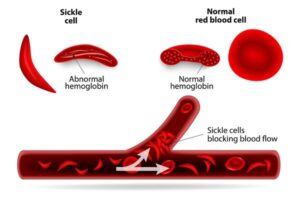proof-of-concept treatment that elevates adult and fetal hemoglobin
Researchers at Philadelphia Children’s Hospital (CHOP) is researching a promising treatment for blood disorders such as sickle cell disease and beta-thalassemia, which could increase hemoglobin levels by activating fetal and adult hemoglobin production. Using a viral vector engineered to reactivate fetal hemoglobin production, suppress mutated hemoglobin, and supply the hemoglobin needed by adults, the researchers developed an approach that could produce more hemoglobin through a single vector. The findings are published in the journal Haematologica.
To date, researchers are examining one of two ways to treat blood disorders such as sickle cell disease or beta-thalassemia: add a functional copy of the adult hemoglobin gene, or increase fetal hemoglobin production. In this study, Philadelphia Hospital researchers conducted simultaneous research on both therapies, which provides an opportunity to produce more hemoglobin per patient in these patients.

Sickle cell disease and beta-thalassemia are genetic disorders of the blood that result from an error in the expression of the genes hemoglobin, a protein found in red blood cells that carries oxygen from the lungs to the body’s tissues. In the uterus, the gamma-globin gene produces fetal hemoglobin, but after birth, the gene shuts down and the beta-globin gene turns on, producing adult hemoglobin. Patients with sickle cell disease and beta-thalassemia have mutations in the beta-globin the gene that results in the production of mutated hemoglobin, resulting in new complications such as growth retardation and jaundice, clinical pain, pulmonary hypertension, and stroke.
Current research has focused on treating these blood disorders, either by increasing fetal hemoglobin or adding a functional version of adult hemoglobin through gene therapy. However, both approaches have limitations, and neither has proven to be a completely therapeutic approach.
To increase hemoglobin levels in one treatment, researchers combined the two tactics into a single gene therapy vector. To do this, they focused on a transcription factor called BCL11A, which effectively works the function and process that shuts off fetal hemoglobin production and activates adult hemoglobin production. The researchers hypothesized that if they could use an engineered vector to suppress the BCL11A gene, which turns fetal hemoglobin production on and inactivates adult mutant hemoglobin production, they could also add a functional version of the beta-globin gene, which could produce Provide more hemoglobin.
Researchers worked in the cell lines of patients with sickle cell disease and beta-thalassemia, tested the engineered vector – which contains the gene for adult hemoglobin and the microRNA sequence that targets BCL11A – and found that the vector was able to measure fetal hemoglobin and adult hemoglobin. Simultaneously raise in the laboratory. Although BCL11A was not completely knocked down, this suppression was sufficient to reduce the production of adult mutant hemoglobin. By increasing fetal and functional adult hemoglobin levels, the vector was able to produce more functional hemoglobin than the beta-globin expression vector alone.
Future studies will evaluate this method using even more powerful vectors developed and recently published in the center’s research laboratories. The research center hopes to combine the two technologies to create a more powerful vector that can provide therapeutic hemoglobin levels for these patients. This research is supported by the CuRED Frontier program at CHOP, which focuses on finding new and improved treatments for blood diseases such as sickle cell disease and beta-thalassemia.
How are sickle cell disease and beta-thalassemia diagnosed?
In addition to a complete medical history and physical examination, methods of these blood disorders include: Examination of CBC test, hemoglobin electrophoresis along molecular tests are helpful in diagnosing these diseases.
Newborn blood tests are now being screened to begin treatment as soon as possible. Early diagnosis is crucial for the preventive treatment of irreversible complications of this disease.


